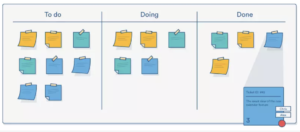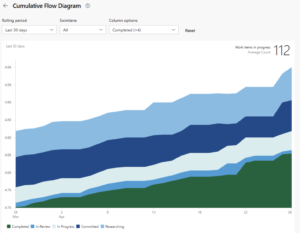Salesforce Kanban: How It Can Help You Maintain Control Over Anything
Controlling workflow processes makes or breaks project success. On average, organizations with workflows clearly defined by proven project management practices waste 28 times less money than others. While many project management and workflow process controls involve radical restructuring of teams and practices, Salesforce users have a powerful and easily implemented process control tool in Salesforce Kanban in the Lightning platform.
Although overall reported satisfaction in process control has been on the rise over the last decade, 54% of project team members still report that the collaboration tools they use lack access to real-time KPIs. As a result, teams spend as much as a full workday every month manually collating project status information.
Organizing your workflows to give teams real-time visibility into task statuses and clearly defining current priorities for everyone involved reduces wasted time and resources. In this guide, you’ll learn how Salesforce Kanban helps you create and maintain precisely this kind of control.
What is Salesforce Kanban?
In 2017, Salesforce replaced the Opportunity Board view in the Salesforce Lightning interface with an object viewing mode called Kanban. Kanban – a Japanese word meaning “sign” or “billboard” – is a workflow process similar to Scrum. The name derives from the use of signs or sticky notes on a Kanban board as a visual process management tool in Japanese lean manufacturing systems such as Toyota.
In Salesforce, Kanban is both a viewing mode in the Agile Accelerator and a process for teams to follow when using that mode.
Kanban View
Kanban view allows multiple record types to be placed in single object lists and rearranged by drag-and-drop. The list headings reflect the current workflow status of records such as Open, Working, or Waiting on Customer. The Agile Accelerator dashboard serves as a virtual Kanban board, allowing records and cases to be easily moved between lists to match changes in status in an intuitive visual display.
Kanban Process
In Salesforce, four features distinguish the Kanban process from other workflow processes.
- Visualized Workflow: Kanban uses virtual cards to represent tasks and other database fields visually in Agile Accelerator.
- Limited Tasks: Kanban limits work in progress or the number of tasks assigned to teams at any given time and directs teams who have finished their current tasks to help others finish theirs before new tasks are given.
- Incremental Change: Kanban doesn’t redesign existing workflows or team processes from the top down. It attempts to improve performance in small, incremental steps.
- Kanban Metrics: Two metrics are unique to Salesforce Kanban. Cycle times measure the average time-to-completion for tasks or cards on the board. Throughput refers to work completed in a given period.
How Salesforce Kanban Helps You Maintain Process Control
For decades companies have used the Kanban framework for process control in products as diverse as cars and software. Regardless of your industry or the kinds of projects your teams handle, adopting Kanban workflows in Salesforce can improve overall efficiency and performance in four distinct ways.
- Rearrange Priorities Without Interruption
When priorities change on the fly, decision-makers need to balance the pros and cons of interrupting current tasks to reorient the project as a whole. Because Kanban limits the scope of immediate tasks and redirects other teams to those tasks first, managers and decision-makers can implement large-scale priority changes at any point in time without needing to individually retask teams or halt their current activities.
- Reduce Cycle Times with Overlapping Responsibility
Reliably predicting how long teams will take to complete new tasks can challenge even experienced organizations. Unanticipated bottlenecks frequently occur when tasks that require particular skill sets accumulate for a few specialized team members.
In Kanban, the longer a single card task drags on, the more other teams who have finished their own tasks become available to share the workload and break up bottlenecks. Although projects may require distributing skill sets among different teams for immediate tasks, the Kanban process concentrates them when unexpected delays happen, ensuring that task cycle times reflect the combined skill of all your teams.
- Refine Performance with Powerful Visual Metrics
Kanban originated as a visual process management tool in factory production. The simple rearrangement of cards in columns on the board gave decision-makers and team members a time-saving medium for monitoring progress and communicating ongoing changes.
In its contemporary iterations in platforms such as Salesforce, Kanban continues to provide the same boost to efficiency through enhanced visibility. Agile Accelerator has two visualization tools teams can use to better understand where exactly they’re excelling or falling behind.
- Control Charts: These charts plot average cycle times against known issues and clusters of issues.
- Cumulative Flow Diagrams: These diagrams indicate the total number of identified issues in each status type. Visualizing progress this way allows teams to recognize bottlenecks early when issues cluster in a single status type.
- Continuous Delivery
With an emphasis on short cycles and limited work in progress, Kanban workflows are optimally suited to continuous delivery. Although the intervals that define continuous delivery vary widely between industries – weeks to months for physical production or daily to hourly in software development – the principle of just-in-time delivery brings value to the marketplace faster than traditional processes. Continuous delivery consistently gives teams a competitive and innovative edge.
Optimize Salesforce Lightning for Your Teams with Rainmaker
Even experienced Salesforce administrators get overwhelmed and face challenges of poor internal communication and misaligned goals. Rainmaker specializes in Salesforce administration and tailored proactive services to help businesses get back on track and deliver on their full potential.
To schedule a video call and learn more, contact Rainmaker today.








